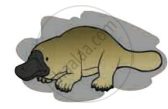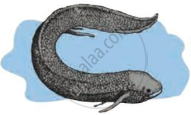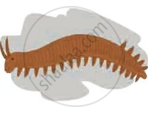Advertisements
Advertisements
प्रश्न
Give scientific reason.
Peripatus is said to be the connecting link between Annelida and Arthropoda.
उत्तर
- Peripatus is the connecting link between two different groups - Annelida and Arthropoda.
- It shows annelid-like characters such as segmented body, thin cuticle, and parapodia-like organs.
- It also shows arthropod-like characters such as tracheal respiration and open circulatory system.
Therefore, Peripatus is said to be the connecting link between Annelida and Arthropoda.
APPEARS IN
संबंधित प्रश्न
Give two examples of vestigial organs in human beings and plants.
(a) Select the homologous structures from the combinations given below:
(i) Forelimbs of whales and bats
(ii) Tuber of potato and sweet potato
(iii) Eyes of octopus and mammals
(iv) Thorns of Bougainvillea and tendrils of Cucurbita
(b) State the kind of evolution they represent.
If you are asked to select a group of two vegetables, out of the following, having homologous structures which one would you select?
(a) Carrot and radish
(b) Potato and sweet potato
(c) Potato and tomato
(d) Lady finger and potato
Which of the following is a correct set of homologous organs?
(a) Forelimbs of frog, bird and lizard
(b) Spine of cactus and thorn of bougainvillea
(c) Wings of bat and wings of butterfly
(d) Wings of a bird and wings of a bat
Which one of the following pairs of vegetables is an example of homologous structures?
(A) Potato and sweet potato
(B) Carrot and radish
(C) Carrot and tomato
(D) Tomato and radish
Four students P, Q, R and S differently reported the following set of organs to be analogous :
P. Forelimb of a frog and forelimb of a lizard
Q. Forelimb of a bird and forelimb of a human
R. Wings of a parrot and wings of a butterfly
S. Wings of a bird and wings of a bat
The two students who have reported correctly are :
(A) P and Q
(B) Q and R
(C) R and S
(D) P and S
Can the wing of a butterfly and the wing of a bat be considered homologous organs? Why or why not?
Explain with an example for the given, how the following provides evidence in favor of evolution in organisms :
Analogous organs
Explain the evolution of giraffe's neck according to Lamarck's theory of evolution.
Name two animals having homologous organs and two having analogous organs. Name these organs.
There are five animals A, B, C, D and E. The animal A uses its modified forelimbs for flying. The animal B uses its forelimbs for running whereas the animal C uses its forelimbs for grasping. The animal D can live on land as well as in water and uses its forelimbs to prop up the front end of its body when at rest. The animal E which respires by using spiracles and tracheae uses wings for flying but its wings are analogous to the modified forelimbs of animal A.
(a) What could the animals A, B, C, D and E be?
(b) Why are the forelimbs of animals A, B, C, D called homologous organs?
(c) What does the existence of homologous organs in animals A, B, C and D tell us about their ancestors ?
(d) Why are the modified forelimbs of animal A and the wings of animal E called analogous organs?
(e) State whether animals A and E have a common ancestor or not.
Select a set of homologous organs from the following:
(A) Wings of a bat and wings of a butterfly
(B) Wings of a pigeon and wings of a bat
(C) Wings of a butterfly and wings of a pigeon
(D) Forelimbs of a duck, forelimbs of a cow and forelimbs of a lizard
The most common types of fossils are ------------------------.
Define fossil.
Very short answer question.
What are homologous organs?
Very short answer question:
What is vestigeal organ?
Enlist the evidences of evolution.
Define the evidence of evolution shown in the figure.

Which evidence of evolution is shown in the given picture? Explain the importance of this evidence.

Write the answers to the questions by observing the figure below.
 |
 |
 |
| (a) | (b) | (c) |
- Write the name of the animal ‘(a)’ in the figure.
- Write the name of the animal ‘(b)’ in the figure.
- Write the name of the animal ‘(c)’ in the figure.
- Which evolutionary evidence is illustrated by this figure?
- Write the definition of that evidence for evolution.
How do you differentiate homologous organs from analogous organs?
Homologous organs and vestigial organs are examples of ______ type of evidence in evolution.
The fossil remains of Archaeopteryx is a connecting link between ______
Where is carbon dating used?
Why do all the gametes formed in human females have an X chromosome?
Evolution has exhibited a greater stability of molecular structure when compared with morphological structures. Comment on the statement and justify your opinion.
Basic principles of embryonic development were pronounced by:
The presence of gill slits, in the embryos of all vertebrates, supports the theory of ______.
Which is not a vestigial organ in a man?
Flippers of Penguins and Dolphins are examples of:
Animal husbandry and plant breeding programmes are the examples of ______.
How do we compute the age of a fossil?
What is the function of the appendix of our digestive system?
Evolutionary convergence is the development of a ______.
Industrial melanism in England after 1850 is an excellent example of Natural selection. Explain how?
